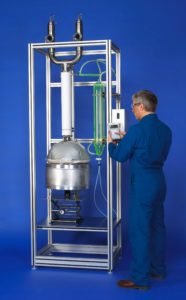 High levels of water in crude oil make fractional distillation difficult. Water has a hard time vaporizing from the boiling flask and getting through the distillation column packing. Water drops in the distillation column head causes fluctuation in the vapor temperature causing inaccurate vapor temperature readings. D2892 requires that crude oil samples have 0.3% water or less. If the crude oil sample has more than 0.3% water then it must be dehydrated before the D2892 test can be performed.
High levels of water in crude oil make fractional distillation difficult. Water has a hard time vaporizing from the boiling flask and getting through the distillation column packing. Water drops in the distillation column head causes fluctuation in the vapor temperature causing inaccurate vapor temperature readings. D2892 requires that crude oil samples have 0.3% water or less. If the crude oil sample has more than 0.3% water then it must be dehydrated before the D2892 test can be performed.
Light crude oils are normally well below the D2892 water limit. Conversely, heavy, sour crude oils are usually “wet”.
Water in crude oil can be in various forms
- free water
- emulsified water
- chemically bound water
Problems caused be water in crude oil:
- Because water is heavier than crude oil it sits on the bottom of the boiling flask with all the crude oil above it. When the water vaporizes a “bump” may be heard and there may be violent shaking of the distillation apparatus as the water tries to break through to the surface of the crude oil. Many times the water does not escape and returns to the bottom of the boiling flask.
- When water does escape from the crude oil into the distillation column packing. It may not having enough energy to stay in the vapor phase. Water beads on the stainless steel column packing and so it doesn’t freely flow back down the column packing to the boiling flask. The water has a difficult time going up the distillation column or down. It is trapped in the packing.
- When water finally makes it to the condenser it can get “stuck” there. Water beads on glass and so doesn’t freely flow back down to the reflux area to be collected. When water does flow back down there are 6 to 1 odds that it will be returned to the distillation column.
- Water forms a droplet on the vapor temperature probe and the vapor temperature decreases. When the water droplet falls from the end of the temperature probe, the vapor temperature goes up.
Dehydration
A de-watering method is described in annex X1 of D2892. It calls for a distillation column without packing to be operated at a 0 reflux ratio. Distillate is collected in a chilled receiver. The absence of column packing and zero reflux ratio accelerate dehydration of the crude oil. Petroleum distillate and water phase separate in the chilled receiver with the water settling at the bottom where it can be drawn off and measured.
After the boiling flask is cooled the distilled petroleum fraction is recombined in the boiling flask with the residue. The charge weight is recalculated by subtracting the amount of water removed.
Butane is collected in the D2892 butane traps the same as if the D2892 test was being performed. The butane weight is recorded but the butane is not blended into the boiling flask because of losses of volatile butane in the re-blending.
Leave a Reply